Plant Growth and Development Chapter Notes | Biology Class 11 - NEET PDF Download
| Table of contents |

|
| Introduction |

|
| Growth and its Characterstics |

|
| Growth Rates |

|
| Quantitative Comparison of Growth |

|
| Differentiation, Dedifferentiation and Redifferentiation |

|
| Plant Growth Regulators (PGRs) |

|
Introduction
- Development is the combination of two processes: growth and differentiation.
- Growth means an increase in size, while differentiation means the formation of different types of cells that have specific functions.
- Development starts with a fertilized egg and follows a precise order to create a complex body with roots, leaves, branches, flowers, fruits, and seeds.
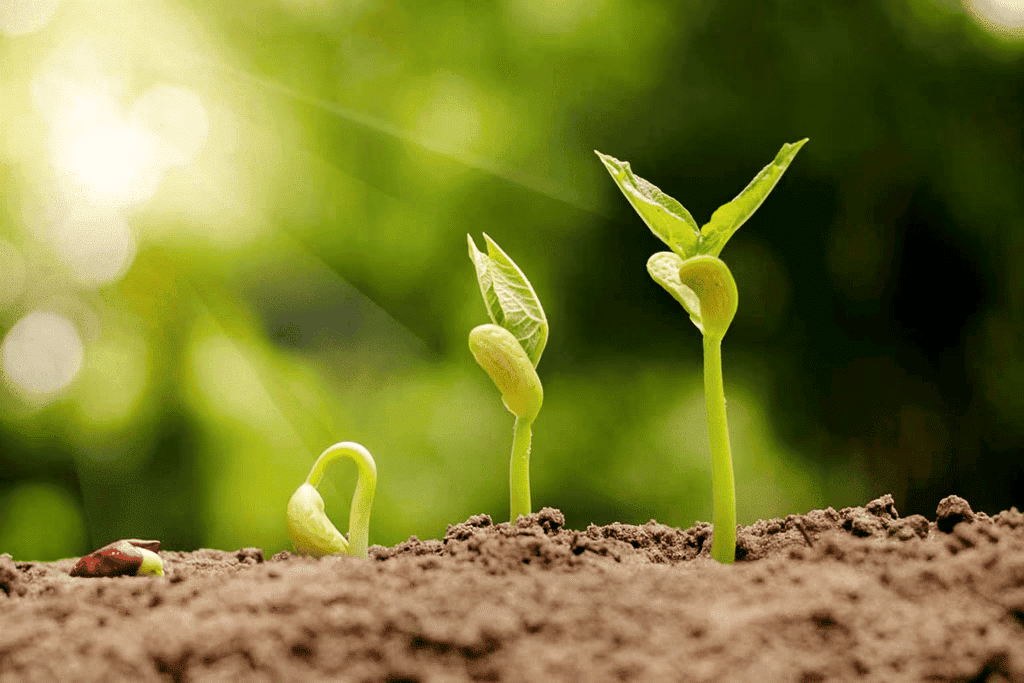
- A plant's development involves making various parts like roots, leaves, branches, flowers, fruits, and seeds, and eventually, the plant dies. The first step in this process is seed germination, which happens when the conditions are right for growth.
- When conditions are not favorable, seeds go into a resting period. Once the right conditions return, seeds start growing again. In this chapter, we will also learn about the factors that control these developmental processes.
Growth and its Characterstics
- Growth is considered one of the most basic and noticeable traits of living beings.
- It can be defined as a permanent and irreversible increase in the size of an organ, its parts, or even an individual cell.
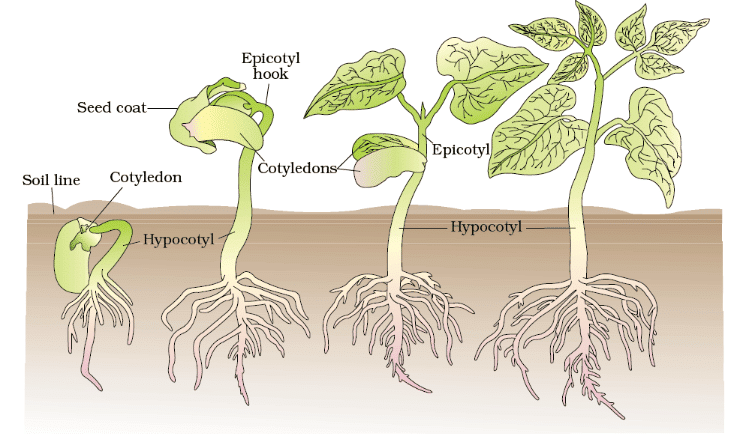 Germination and seedling development in bean
Germination and seedling development in bean
- Generally, growth is associated with metabolic processes, both anabolic (building up) and catabolic (breaking down), which require energy.
- For example, when a leaf expands, it is a sign of growth.
- On the other hand, the swelling of a piece of wood when placed in water is not growth.
- This phenomenon is due to imbibition, which is the physical process of a substance absorbing water and swelling.
(i) Plant Growth Generally is Indeterminate
- Plants exhibit indeterminate growth, meaning they can grow continuously throughout their life. This is possible because of the presence of meristems in certain parts of the plant.
- Meristems consist of cells that have the ability to divide and self-perpetuate. These cells can produce new cells that eventually lose the capacity to divide, making up the majority of the plant body.
- Open Form of Growth. This type of growth involves the continuous addition of new cells to the plant body by active meristems.
- Apical Meristems. These are found at the tips of roots and shoots and are responsible for the primary growth of plants, leading to elongation along the axis.
- Lateral Meristems. Found later in the life of dicotyledonous plants and gymnosperms, these include the vascular cambium and cork cambium, which are responsible for secondary growth, increasing the girth of the plant.
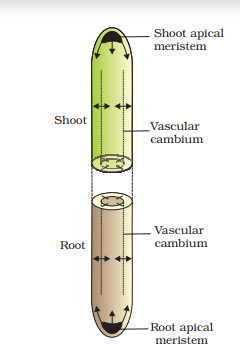 Diagrammatic representation of locations of root apical meristem, shoot aplical meristem and vascular cambium. Arrows exhibit the direction of growth of cells and organ
Diagrammatic representation of locations of root apical meristem, shoot aplical meristem and vascular cambium. Arrows exhibit the direction of growth of cells and organ
(ii) Growth is Measurable
Growth at the cellular level is mainly due to the increase in protoplasm. Since it is hard to measure protoplasm directly, scientists use various parameters that are proportional to it. Growth can be measured by looking at factors like:
- Increase in fresh weight
- Increase in dry weight
- Increase in length
- Increase in area
- Increase in volume
- Increase in cell number
Different organisms show growth in different ways. For example:
- A single maize root apical meristem can produce over 17,500 new cells per hour, indicating growth through cell number.
- In watermelon, cells can increase in size by up to 3,50,000 times, showing growth through cell size.
Other examples include:
- Pollen tube growth is measured by its length.
- Growth in a dorsiventral leaf is indicated by an increase in surface area.
(iii) Phases of Growth
The process of growth is typically categorized into three phases: meristematic, elongation, and maturation.
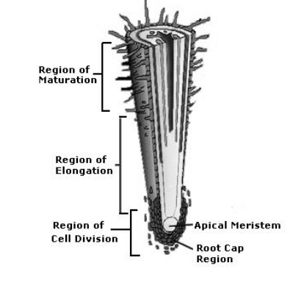 Phases of Growth
Phases of Growth
Meristematic Phase
- This phase is characterized by constantly dividing cells at the root and shoot tips.
- The cells in this region are rich in protoplasm, have large and prominent nuclei, and their cell walls are primary, thin, cellulosic, and contain abundant plasmodesmatal connections.
Elongation Phase
- Just above the meristematic zone, the cells enter the elongation phase.
- This phase is marked by increased vacuolation, cell enlargement, and the deposition of new cell walls.
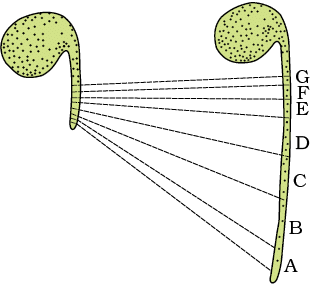 Detection of zones of elongation by the parallel line technique. Zones A, B, C, D immediately behind the apex have elongated most.
Detection of zones of elongation by the parallel line technique. Zones A, B, C, D immediately behind the apex have elongated most.
Maturation Phase
- Further away from the tip, the cells enter the maturation phase.
- In this phase, cells reach their maximum size with thickened walls and protoplasmic modifications.
- Most of the tissues and cell types studied in earlier classes correspond to this phase.
Growth Rates
Growth rate refers to the increased growth per unit time and can be expressed mathematically. Growth can be arithmetic or geometrical, depending on how cells are produced.
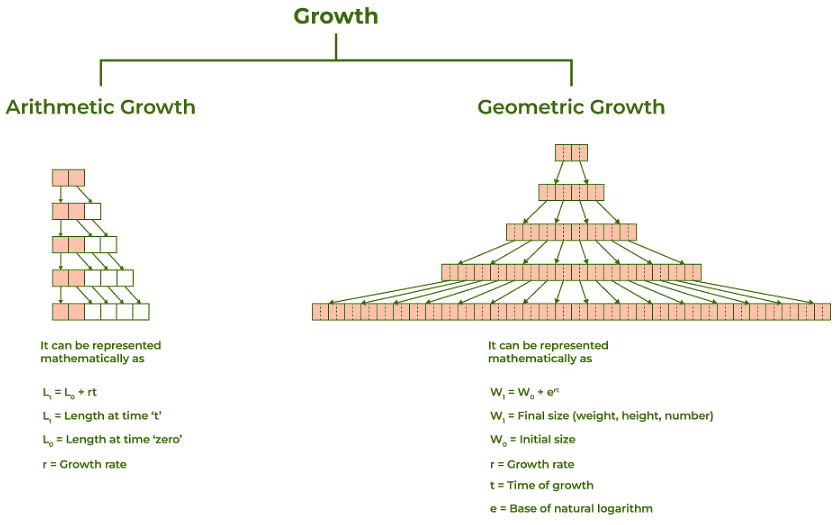
(i) Arithmetic Growth
- In arithmetic growth, after mitotic cell division, only one daughter cell continues to divide while the other differentiates and matures.
- A simple example of arithmetic growth is a root elongating at a constant rate.
- When plotting the length of the organ against time, a linear curve is obtained.
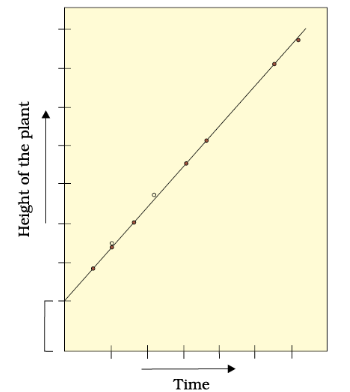 Arithmetic Growth Graphical Representation
Arithmetic Growth Graphical Representation
Mathematically, it is expressed as
Lt = L0 + rt
Lt = length at time ‘t’
L0 = length at time ‘zero’
r = growth rate / elongation per unit time.
(ii) Geometric Growth
- Geometrical growth begins with a lag phase followed by rapid increase at an exponential rate (log or exponential phase).
- During this phase, both progeny cells retain the ability to divide after mitotic cell division.
- However, with limited nutrient supply, growth slows down leading to a stationary phase.
- When plotting growth parameters against time, a typical sigmoid or S-curve is obtained.
- The sigmoid curve is characteristic of living organisms growing in a natural environment and is typical for all cells, tissues, and organs of a plant.
 Geometric Growth Graphical RepresentationThe exponential growth can be expressed as
Geometric Growth Graphical RepresentationThe exponential growth can be expressed as
W1 = W0 ert
W1 = final size (weight, height, number etc.)
W0 = initial size at the beginning of the period
r = growth rate
t = time of growth
e = base of natural logarithms
Quantitative Comparison of Growth
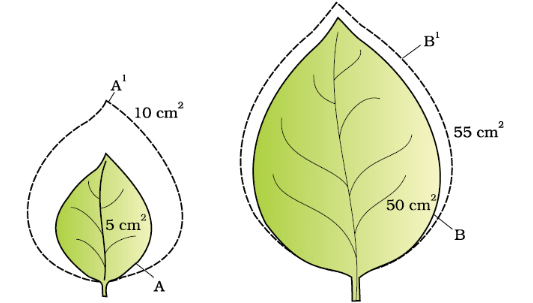 Diagrammatic comparison of absolute and relative growth rates. Both leaves A and B have increased their area by 5 cm2 in a given time to produce A1 , B1 leaves.
Diagrammatic comparison of absolute and relative growth rates. Both leaves A and B have increased their area by 5 cm2 in a given time to produce A1 , B1 leaves.
- Absolute Growth Rate: This refers to the total growth of a living system per unit time. It involves measuring and comparing the total growth without any specific basis for comparison, such as the initial size or mass.
- Relative Growth Rate: This measures the growth of a system per unit time, but expresses it on a common basis, such as per unit of the initial parameter (e.g., per unit initial size or mass). It provides a way to compare growth rates relative to the starting point.
Conditions for Growth
- Water: Water is crucial for plant growth as it is needed for cell enlargement, which is a key part of how plant cells grow in size. Turgidity, or the fullness of plant cells with water, is essential for extension growth. Additionally, water provides the medium for enzymatic activities that are necessary for growth.
- Oxygen: Oxygen is important for releasing metabolic energy, which is essential for various growth activities in plants.
- Nutrients: Plants require both macro and micro nutrients for the synthesis of protoplasm and as a source of energy. These nutrients are vital for various metabolic processes and overall growth.
- Optimum Temperature: Every plant has a specific temperature range that is best suited for its growth. Deviation from this range can be harmful to the plant's survival.
- Environmental Signals: Factors such as light and gravity also influence certain phases or stages of plant growth. For example, light is crucial for photosynthesis and other growth processes, while gravity helps in orienting plant growth.
Differentiation, Dedifferentiation and Redifferentiation
- Differentiation. It is the process by which cells derived from root apical and shoot-apical meristems and cambium mature to perform specific functions. During this process, cells undergo structural changes in their cell walls and protoplasm. For instance, to form a tracheary element, cells lose their protoplasm and develop strong, elastic, lignocellulosic secondary cell walls to transport water over long distances under tension.
- Dedifferentiation. It is an interesting phenomenon where living differentiated cells, which have lost the capacity to divide, can regain the ability to divide under certain conditions. This process leads to the formation of new meristems, such as interfascicular cambium and cork cambium, from fully differentiated parenchyma cells.
- Redifferentiation. After dedifferentiation, the newly formed meristems or tissues can divide and produce cells that once again lose the capacity to divide but mature to perform specific functions. This process is called redifferentiation. Examples of Redifferentiation in Woody Dicotyledonous Plants: Heartwood and sapwood in trees, Cork cambium producing cork, Pith parenchyma cells transforming into sclereids.
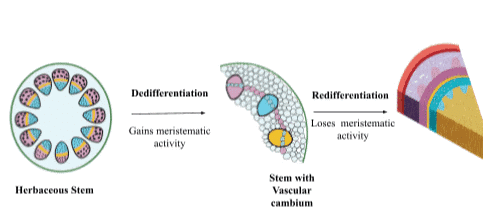
- Tumours in Plants. Tumours in plants are abnormal growths of tissue that can occur due to various factors such as injury, infection, or genetic mutations. They can be described as localized areas of uncontrolled cell division.
- Parenchyma Cells in Plant Tissue Culture. In plant tissue culture, parenchyma cells that are induced to divide under controlled laboratory conditions are called callus. Callus formation is an essential step in plant tissue culture as it serves as a source of undifferentiated cells that can be induced to form shoots, roots, or entire plants.
- Open Differentiation in Plants. Just like growth in plants is open, differentiation is also open. Cells and tissues arising from the same meristem can have different structures at maturity based on their location. For example, cells positioned away from root apical meristems differentiate into root-cap cells, while those pushed to the periphery mature into epidermis.
Development
Development refers to the entire range of changes an organism undergoes throughout its life, from the moment a seed germinates to the time it reaches old age. In plants, development includes various processes that lead to the formation of different structures and organs, and it is influenced by both internal and external factors.
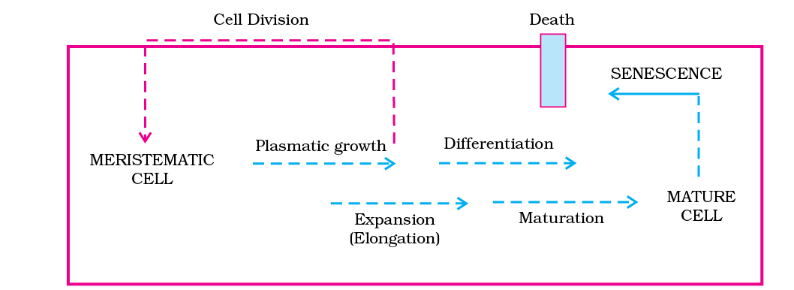 Sequence of the developmental process in a plant cell
Sequence of the developmental process in a plant cell
Plasticity in Plants
- Plants have the ability to respond to their environment and different stages of life by forming various structures. This ability is known as plasticity.
- For example, in plants like cotton, coriander, and larkspur, the leaves of young plants (juvenile stage) are shaped differently compared to the leaves of mature plants.
- Another example of plasticity is seen in the buttercup, where leaves produced in air have a different shape than those produced in water.
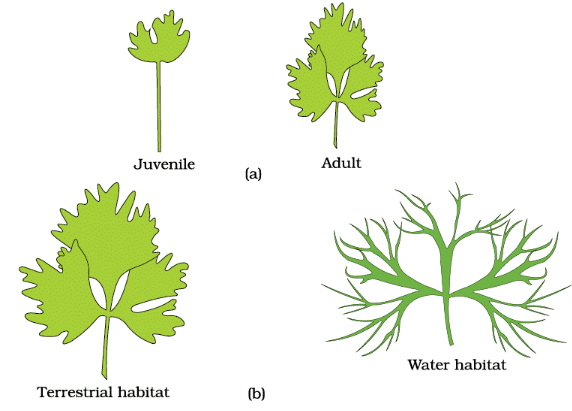 Heterophylly in (a) larkspur and (b) buttercup
Heterophylly in (a) larkspur and (b) buttercup
Relationship Between Growth, Differentiation, and Development
- Growth, differentiation, and development are interconnected processes in a plant's life. Development is often considered the combination of growth and differentiation.
- Growth refers to the increase in size, differentiation involves the formation of specialized cells and tissues, and development encompasses both these aspects along with the overall progression of the plant.
Factors Influencing Development
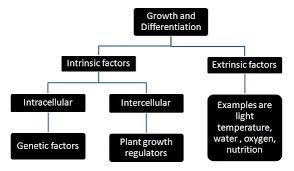 Factors Influencing Development
Factors Influencing Development
(i) Intrinsic Factors:These are internal factors that regulate development. They include:
- Genetic Factors: The plant's genetic makeup plays a crucial role in determining its growth and development.
- Intercellular Factors: Chemicals such as plant growth regulators (hormones) influence the development of plant tissues and organs.
(ii) Extrinsic Factors: These are external factors that affect development. They include:
- Light: The amount and quality of light impact processes like photosynthesis and flowering.
- Temperature: Temperature affects metabolic rates and developmental processes.
- Water: Water is essential for physiological processes and influences growth.
- Oxygen: Oxygen is necessary for respiration, which provides energy for growth.
- Nutrition: The availability of nutrients affects overall health and development.
Plant Growth Regulators (PGRs)
(i) Characterstics
Plant Growth Regulators (PGRs) are small, simple molecules with diverse chemical compositions. They include: Indole Compounds: Such as Indole-3-Acetic Acid (IAA), which is a type of auxin. Adenine Derivatives: Like N6-furfurylamino purine (Kinetin), which is a type of cytokinin. Derivatives of Carotenoids: Such as Abscisic Acid (ABA). Terpenes: Like Gibberellic Acid (GA3). Gases: Such as Ethylene (C2H4).PGRs are also known as plant growth substances, plant hormones, or phytohormones. They can be broadly divided into two groups based on their functions:
1. Growth Promoting PGRs: These PGRs are involved in various growth-promoting activities, such as: Cell DivisionCell EnlargementPattern FormationTropic GrowthFloweringFruitingSeed Formation Examples include Auxins, Gibberellins, and Cytokinins.
2. Growth Inhibiting and Stress Response PGRs: These PGRs play a role in plant responses to wounds and stresses of biotic and abiotic origin. They are also involved in various growth-inhibiting activities such as: DormancyAbscission Abscisic Acid (ABA) is an example of this group. Ethylene, being a gaseous PGR, could fit into either group, but it is largely considered an inhibitor of growth activities.
(ii) Discovery of Plant Growth Regulators
The discovery of the five major groups of Plant Growth Regulators (PGRs) was quite accidental and fascinating. It all began with Charles Darwin and his son Francis Darwin, who noticed that the coleoptiles (the protective sheath covering the emerging shoot) of canary grass bent towards a unilateral light source, demonstrating phototropism. Through a series of experiments, they concluded that the tip of the coleoptile was responsible for transmitting an influence that caused the entire coleoptile to bend.1. Auxins
- Discovery: Auxin was isolated by F.W. Went from the tips of oat coleoptiles.
- Role: Auxins are responsible for promoting cell elongation, particularly in response to light, as seen in phototropism.
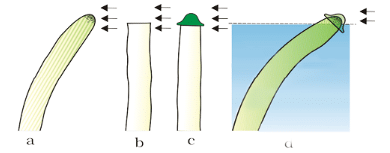 Experiment used to demonstrate that tip of the coleoptile is the source of auxin. Arrows indicate direction of light
Experiment used to demonstrate that tip of the coleoptile is the source of auxin. Arrows indicate direction of light
2. Gibberellins
- Discovery: The ‘bakanae’ (foolish seedling) disease of rice, caused by the fungus Gibberella fujikuroi, led to the discovery of gibberellic acid.
- Research: E. Kurosawa (1926) found that sterile filtrates of the fungus caused symptoms in rice seedlings, and the active substances were later identified as gibberellic acid.
3. Cytokinins
- Discovery: F. Skoog and his team observed that callus from tobacco stems proliferated only when auxins were supplemented with certain nutrients.
- Identification: Miller et al. (1955) identified and crystallized the cytokinesis-promoting substance, naming it kinetin.
4. Abscisic Acid (ABA)
- Discovery: During the mid-1960s, three independent studies reported the purification and characterization of different inhibitors.
- Research: These inhibitors were found to be chemically identical and were named abscisic acid (ABA).
5. Ethylene
- Discovery: H.H. Cousins (1910) observed that a volatile substance from ripened oranges accelerated the ripening of stored unripened bananas.
- Identification: This substance was later identified as ethylene, a gaseous PGR.
(iii) Physiological Effects of Plant Growth Regulators
1. Auxins
- Auxins, derived from the Greek word 'auxein' meaning 'to grow,' were initially isolated from human urine. The term 'auxin' refers to indole-3-acetic acid (IAA) and other natural or synthetic compounds with similar growth-regulating properties.
- Auxins are typically produced by the growing tips of stems and roots and then migrate to the areas where they exert their effects.
- Naturally occurring auxins like IAA and indole butyric acid (IBA) have been isolated from plants, while synthetic auxins such as naphthalene acetic acid (NAA) and 2,4-dichlorophenoxyacetic acid (2,4-D) are widely used.
- Auxins play a crucial role in various agricultural and horticultural practices, including:
1. Initiating Rooting: Auxins like IAA and IBA are commonly used to promote rooting in stem cuttings, a technique widely employed for plant propagation.
2. Promoting Flowering: Auxins can stimulate flowering in certain plants, such as pineapples.
3. Preventing Early Drop: Auxins help prevent the premature drop of fruits and leaves at early stages but promote the abscission of older, mature leaves and fruits.
4. Apical Dominance: The growing apical bud, which produces auxins, inhibits the growth of lateral (axillary) buds. This phenomenon, known as apical dominance, is why removing shoot tips (decapitation) encourages the growth of lateral buds. This technique is commonly used in tea plantations and hedge-making.
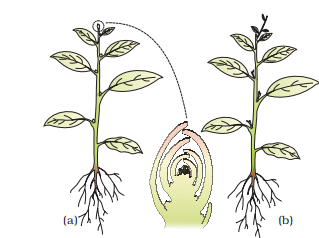 Apical dominance in plants : (a) A plant with apical bud intact (b) A plant with apical bud removed Note the growth of lateral buds into branches after decapitation.
Apical dominance in plants : (a) A plant with apical bud intact (b) A plant with apical bud removed Note the growth of lateral buds into branches after decapitation.
5. Inducing Parthenocarpy: Auxins can induce parthenocarpy, the development of fruit without fertilization, as seen in tomatoes.
6. Herbicides: Synthetic auxins like 2,4-D are used as herbicides to kill dicotyledonous weeds without harming mature monocotyledonous plants. Gardeners use 2,4-D to prepare weed-free lawns.
7. Xylem Differentiation and Cell Division: Auxins also play a role in xylem differentiation and promote cell division in plants.
2. Gibberellins
Gibberellins are a type of plant growth regulator (PGR) that promotes various physiological responses in plants. There are over 100 different gibberellins identified in organisms such as fungi and higher plants, and they are typically labeled as GA1, GA2, GA3, and so on. Gibberellic acid (GA3) was one of the first gibberellins discovered and is the most extensively studied. All gibberellins are acidic in nature.
- Growth Promotion: Gibberellins are known for their ability to increase the length of plant axes, which is why they are used to enhance the length of grape stalks.
- Fruit Development: Gibberellins promote the elongation and improvement of the shape of fruits like apples. They also delay the senescence (aging) of fruits, allowing them to remain on the tree longer and extending their market period.
- Brewing Industry: GA3 is used to accelerate the malting process in the brewing industry.
- Sugarcane Cultivation: Spraying sugarcane crops with gibberellins increases stem length and carbohydrate storage as sugar in the stems, leading to higher yields of up to 20 tonnes per acre.
- Conifer Maturity: Spraying juvenile conifer trees with gibberellins hastens their maturity period, resulting in earlier seed production.
- Bolting Promotion: Gibberellins promote bolting, which is the internode elongation just before flowering, in plants such as beet, cabbages, and other plants with a rosette habit.
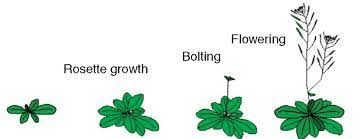 Bolting Promotion by Gibberellins
Bolting Promotion by Gibberellins
3. Cytokinins
- Cytokinins are plant hormones that play a crucial role in cytokinesis, the process of cell division.
- They were first discovered in a modified form of adenine called kinetin, which was extracted from autoclaved herring sperm DNA.
- However, kinetin does not occur naturally in plants.
- Zeatin, a natural cytokinin, was later isolated from corn kernels and coconut milk.
- Since then, several other naturally occurring cytokinins and synthetic compounds that promote cell division have been identified.
- Natural cytokinins are produced in areas of the plant where rapid cell division is happening, such as root tips, developing shoot buds, and young fruits.
- They are responsible for various developmental processes, including the formation of new leaves and chloroplasts, lateral shoot growth, and the formation of adventitious shoots.
- Cytokinins also help to overcome apical dominance, allowing for more lateral growth, and promote the mobilization of nutrients, which can delay leaf senescence (aging).
4. Ethylene
- Ethylene is a simple gaseous plant growth regulator (PGR) that is produced in large quantities by tissues undergoing senescence (aging) and by ripening fruits.
- It has several influences on plants, including:
- Horizontal growth of seedlings
- Swelling of the axis and formation of the apical hook in dicot seedlings
- Promoting senescence and abscission (shedding) of plant organs, especially leaves and flowers
- Ethylene is highly effective in fruit ripening as it enhances the respiration rate during this process, leading to a phenomenon known as the respiratory climactic. This increased respiration rate is a key factor in fruit ripening.
- It also plays a role in breaking seed and bud dormancy, initiating germination in peanut seeds, and sprouting of potato tubers.
- In deep water rice plants, ethylene promotes rapid elongation of internodes and petioles, helping the leaves and upper parts of the shoot remain above water.
- Additionally, ethylene promotes root growth and root hair formation, increasing the plant's absorption surface.
- Ethylene is used in agriculture to initiate flowering and synchronize fruit set in pineapples, as well as to induce flowering in mangoes.
- Ethephon, a compound that releases ethylene slowly, is commonly used in agriculture. It is readily absorbed and transported within the plant when applied in an aqueous solution.
- Ethephon hastens fruit ripening in tomatoes and apples, accelerates abscission in flowers and fruits (such as thinning of cotton, cherry, and walnut), and promotes the formation of female flowers in cucumbers, thereby increasing yield.
5. Abscisic acid
Abscisic acid (ABA) was discovered for its role in regulating abscission and dormancy. But like other PGRs, it also has other wide ranging effects on plant growth and development.
- It acts as a general plant growth inhibitor and an inhibitor of plant metabolism.
- ABA inhibits seed germination.
- ABA stimulates the closure of stomata and increases the tolerance of plants to various kinds of stresses.
- Therefore, it is also called the stress hormone.
- ABA plays an important role in seed development, maturation and dormancy.
- By inducing dormancy, ABA helps seeds to withstand desiccation and other factors unfavourable for growth.
- In most situations, ABA acts as an antagonist to GAs.
We may summarise that for any and every phase of growth, differentiation and development of plants, one or the other PGR has some role to play. Such roles could be complimentary or antagonistic. These could be individualistic or synergistic.
- Similarly, there are a number of events in the life of a plant where more than one PGR interact to affect that event, e.g., dormancy in seeds/ buds, abscission, senescence, apical dominance, etc.
Remember, the role of PGR is of only one kind of intrinsic control. Along with genomic control and extrinsic factors, they play an important role in plant growth and development.
- Many of the extrinsic factors such as temperature and light, control plant growth and development via PGR.
- Some of such events could be: vernalisation, flowering, dormancy, seed germination, plant movements, etc.
|
150 videos|399 docs|136 tests
|
FAQs on Plant Growth and Development Chapter Notes - Biology Class 11 - NEET
| 1. What are the different phases of growth in plants? |  |
| 2. What is vernalization and how does it affect plant growth? |  |
| 3. How do plant growth regulators impact plant growth? |  |
| 4. What is the significance of seed dormancy in plant growth? |  |
| 5. How does redifferentiation contribute to plant growth and development? |  |















